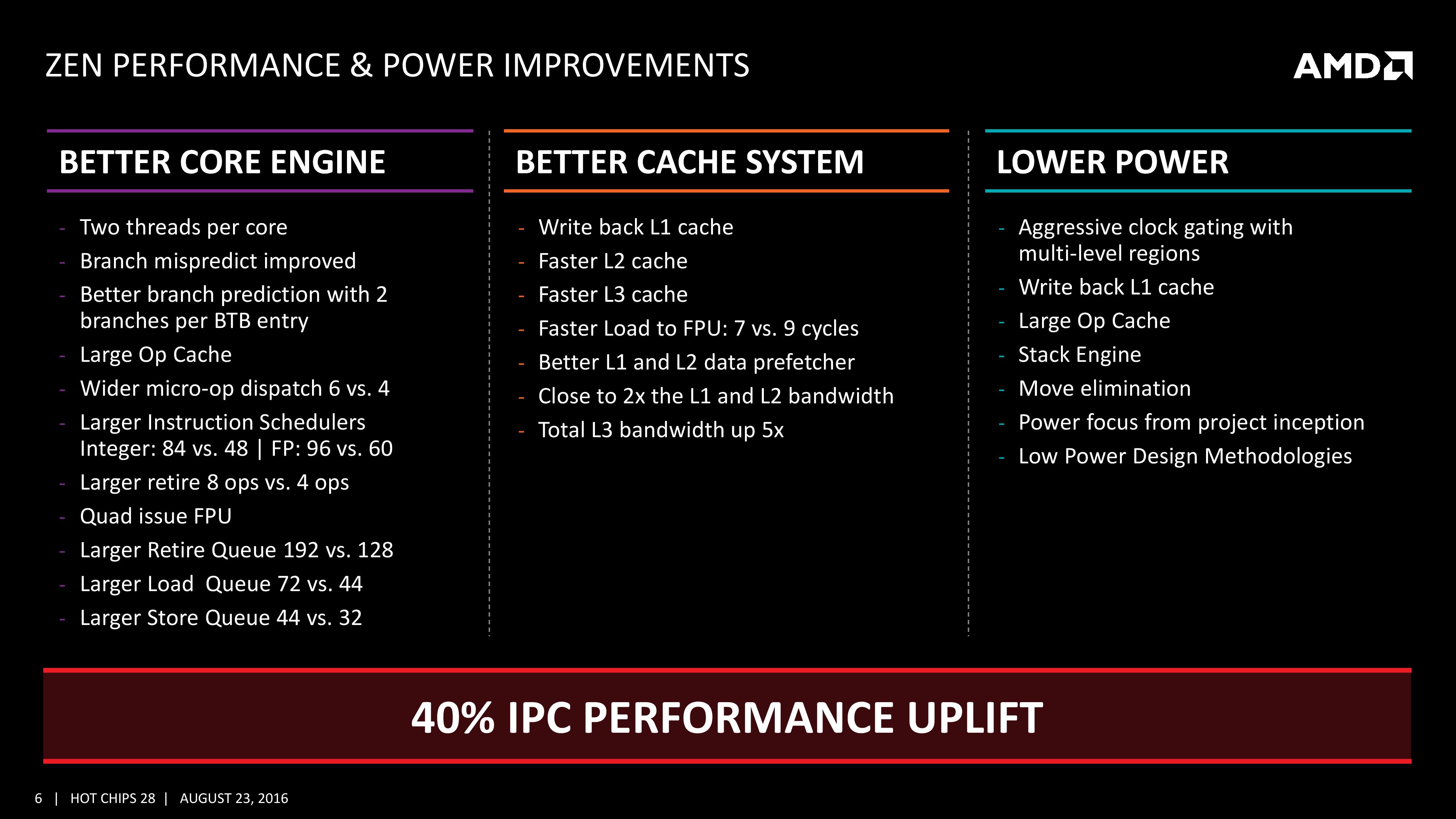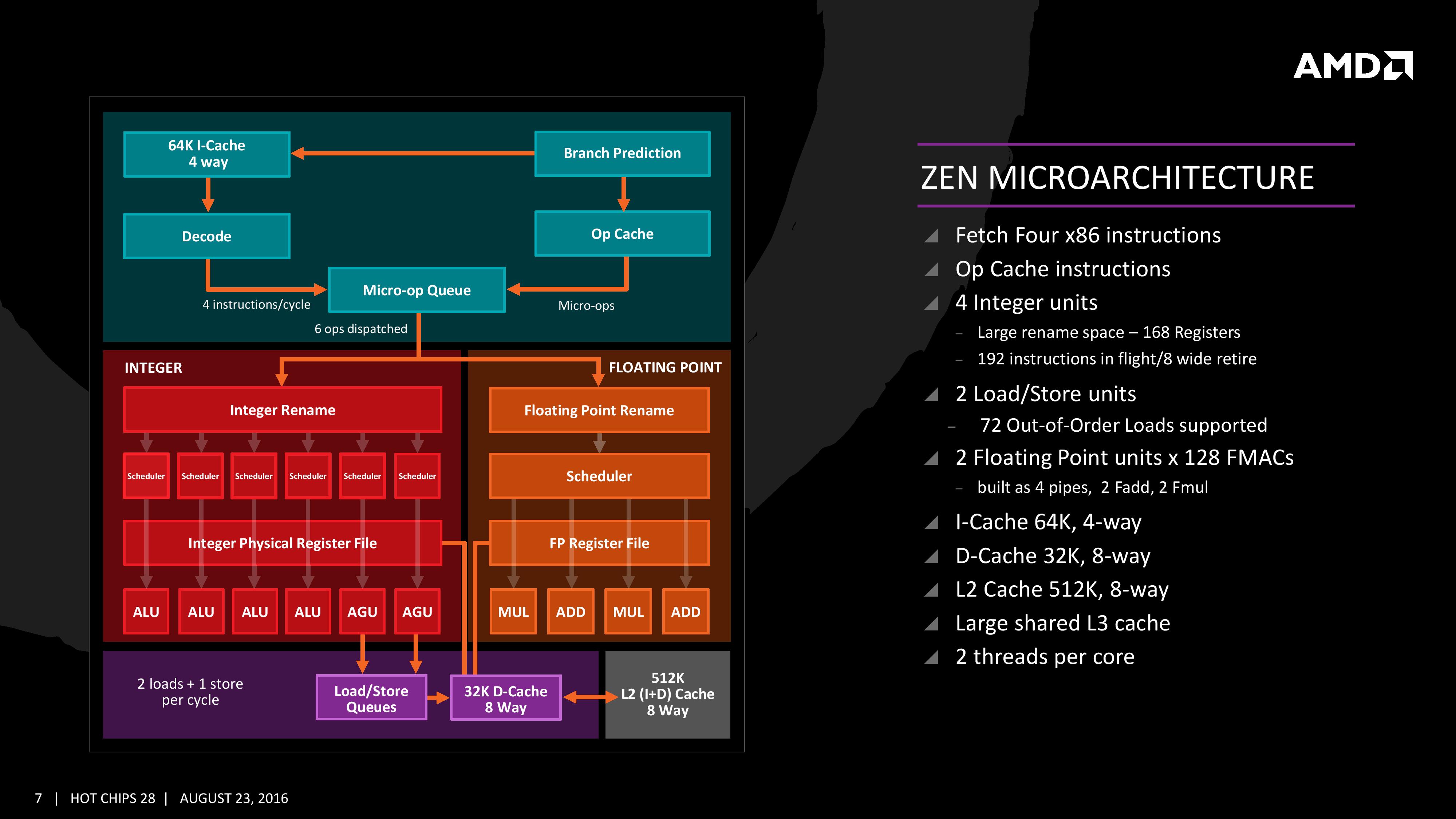AMD Zen Microarchiture Part 2: Extracting Instruction-Level Parallelism
by Ian Cutress on August 23, 2016 8:45 PM EST- Posted in
- CPUs
- AMD
- x86
- Zen
- Microarchitecture
The High-Level Zen Overview
AMD is keen to stress that the Zen project had three main goals: core, cache and power. The power aspect of the design is one that was very aggressive – not in the sense of aiming for a mobile-first design, but efficiency at the higher performance levels was key in order to be competitive again. It is worth noting that AMD did not mention ‘die size’ in any of the three main goals, which is usually a requirement as well. Arguably you can make a massive core design to run at high performance and low latency, but it comes at the expense of die size which makes the cost of such a design from a product standpoint less economical (if AMD had to rely on 500mm2 die designs in consumer at 14nm, they would be priced way too high). Nevertheless, power was the main concern rather than pure performance or function, which have been typical AMD targets in the past. The shifting of the goal posts was part of the process to creating Zen.
This slide contains a number of features we will hit on later in this piece but covers a number of main topics which come under those main three goals of core, cache and power.
For the core, having bigger and wider everything was to be expected, however maintaining a low latency can be difficult. Features such as the micro-op cache help most instruction streams improve in performance and bypass parts of potentially long-cycle repetitive operations, but also the larger dispatch, larger retire, larger schedulers and better branch prediction means that higher throughput can be maintained longer and in the fastest order possible. Add in dual threads and the applicability of keeping the functional units occupied with full queues also improves multi-threaded performance.
For the caches, having a faster prefetch and better algorithms ensures the data is ready when each of the caches when a thread needs it. Aiming for faster caches was AMD’s target, and while they are not disclosing latencies or bandwidth at this time, we are being told that L1/L2 bandwidth is doubled with L3 up to 5x.
For the power, AMD has taken what it learned with Carrizo and moved it forward. This involves more aggressive monitoring of critical paths around the core, and better control of the frequency and power in various regions of the silicon. Zen will have more clock regions (it seems various parts of the back-end and front-end can be gated as needed) with features that help improve power efficiency, such as the micro-op cache, the Stack Engine (dedicated low power address manipulation unit) and Move elimination (low-power method for register adjustment - pointers to registers are adjusted rather than going through the high-power scheduler).
The Big Core Diagram
We saw this diagram last week, but now we get updates on some of the bigger features AMD wants to promote:
The improved branch predictor allows for 2 branches per Branch Target Buffer (BTB), but in the event of tagged instructions will filter through the micro-op cache. On the other side, the decoder can dispatch 4 instructions per cycle however some of those instructions can be fused into the micro-op queue. Fused instructions still come out of the queue as two micro-ops, but take up less buffer space as a result.
As mentioned earlier, the INT and FP pipes and schedulers are separated, but the INT rename space is 168 registers wide, which feeds into 6x14 scheduling queues. The FP employs as 160 entry register file, and both the FP and INT sections feed into a 192-entry retire queue. The retire queue can operate at 8 instructions per cycle, moving up from 4/cycle in previous AMD microarchitectures.
The load/store units are improved, supporting a 72 out-of-order loads, similar to Skylake. We’ll discuss this a bit later. On the FP side there are four pipes (compared to three in previous designs) which support combined 128-bit FMAC instructions. These cannot be combined for one 256-bit AVX2, but can be scheduled for AVX2 over two instructions.












106 Comments
View All Comments
tipoo - Wednesday, August 31, 2016 - link
Meanwhile Intel worked on shortening pipelines...Curious to see how this will go, hope for AMDs sake it's competitive.masouth - Friday, September 2, 2016 - link
I hope it works out for AMD as well but reading about long pipelines and higher freqs always reminds me of the P4 days/shudder
junky77 - Wednesday, August 24, 2016 - link
The problem is now having Intel/AMD provide fast enough CPUs to feed the new GPUs that don't seem to slow down..gamerk2 - Wednesday, August 24, 2016 - link
Pretty much anything from an i7 920 onward can keep GPUs fed these days. For gaming purposes, CPUs haven't been the bottleneck for over a decade. That's why you don't see significant improvement from generation to generation, since our favorite CPU tests happen to be with GPU sensitive benchmarks.Death666Angel - Thursday, August 25, 2016 - link
The story is much more complicated than you are making it seem:https://www.youtube.com/watch?v=frNjT5R5XI4
tipoo - Wednesday, August 31, 2016 - link
A Skylake i3 presents better frametimes than old i7s like the 920 or 2500Krhysiam - Wednesday, August 24, 2016 - link
40% over Excavator probably still puts it well behind even Haswell on IPC. If I'm looking at it right, Bench on this site has 4 single threaded tests (3 Cinebench versions and 3D Particle...). I crunched some numbers and found that if you add 40% to Excavator @ 4Ghz (X4 860 turbo), it still loses to Skylake @ 3.9Ghz (turbo) by between 32% & 39% across the four benchmarks. Haswell @ 3.9Ghz (turbo) would still be faster by 24% to 33%.If it really is 40% minimum, AND they can sustain decent clock speeds, then that's at least enough to be in the ballpark, but it's still well short of Intel in those few benchmarks at least. TBH I don't know how representative those benchmarks are of overall single-threaded performance.
It could well be a case of AMD offering significantly poorer lightly threaded performance, but a genuine 8 core CPU at an affordable (i.e. not $1000) price.
gamerk2 - Wednesday, August 24, 2016 - link
I except the following:~40% average IPC gain in FP workloads
~30% average IPC gain in INT workloads
~20% clock speed reduction.
Average performance increase: ~15-20%, or Ivy Bridge i7 level performance.
Michael Bay - Wednesday, August 24, 2016 - link
Well, nothing stops them from their own brand of tick-tock, especially considering largely stagnant intel IPC.looncraz - Wednesday, August 24, 2016 - link
40% over Excavator is almost exactly Haswell overall, particularly once you shape the performance to match what is known about Zen.http://excavator.looncraz.net/